
Replies sorted oldest to newest
Mais alguma info. sobre essa foto?
A palavra impressa significa "exposição pós-guerra",segundo o google translator.
Tá com cara de photoshop. As Balkenkreutz, as suásticas e as letras estão todas em tonalidades diferentes do resto da foto.
[].
"TB863 by this time had been issued with the squadron code letters UT-D, and for the 1950 SBAC Farnborough Air Show the squadrons aircraft were repainted to represent yellow-nose Messerschmitt Bf109’s, with the iron cross and swastika, but retaining their code letters. This was a re-enactment of the famous wartime precision bombing raid on Amiens prison by Mosquitos of No.487 squadron"
Só encontrei isso, referente à foto.
Tá com cara de photoshop. As Balkenkreutz, as suásticas e as letras estão todas em tonalidades diferentes do resto da foto.
[].
Concordo. Tá com toda a pinta de foto editada.
Parece que esta foto é verdadeira, pois tinha lido que usaram Spits numa filmagem de guerra, como não haviam mais Bf-109s disponíveis....
Elmo, qual é a sua de você para com os alemães? ![]()
Pergunte ao Priller e aos "garotos de Abbeville" do JG 26 e JG 2 como eles gostavam dos Spetos... fritos, claro!![]()
![]()
Elmo, qual é a sua de você para com os alemães? ![]()
Pergunte ao Priller e aos "garotos de Abbeville" do JG 26 e JG 2 como eles gostavam dos Spetos... fritos, claro!![]()
![]()
Que nada, Brettas! Abri o tópico pra te cutucar. Eu sabia que você apareceria por aqui!![]()
![]()
![]()
![]()
![]()
![]()
![]()
Xeriiiiife, olha aí trolagem!!![]()
![]()
![]()
"TB863 by this time had been issued with the squadron code letters UT-D, and for the 1950 SBAC Farnborough Air Show the squadrons aircraft were repainted to represent yellow-nose Messerschmitt Bf109’s, with the iron cross and swastika, but retaining their code letters. This was a re-enactment of the famous wartime precision bombing raid on Amiens prison by Mosquitos of No.487 squadron"
Só encontrei isso, referente à foto.
Pode ser, reparem que a pintura do spinner se prolonga até o começo da capota do motor perto do primeiro escape e lá não parece montagem, acredito que isso não era padrão de pintura dos ingleses. Essas marcações podem ser adesivos um pouco mais brilhantes.
Concordo, Paulão. A suástica da cauda tá mt destoante.
Pintura feita para um filme na década 60.
Um abraço e t+![]()
Pintura feita para um filme na década 60.
Um abraço e t+![]()
isso é que é ser sucinto.
Pintura feita para um filme na década 60.
Um abraço e t+![]()
isso é que é ser sucinto.
2!
![]()
[]s!!!
Em um filmezinho até que interessante. Passou algumas vezes no TCM.
Me senti prolixo agora!![]()
Um abraço e t+![]()
Bom dia.
Alguns dados coletados:
Spitifires que foram tripulados por alemães
DB Daimler-Benz AG, Testcentre for aero-engines at airfield Echterdingen (near Boblingen, South of Stuttgart).
DLV Deutsche Luft- und Versuchsanstalt at Oberpfaffenhofen SW of Munich,, a German Aero and Experimental Establishment; Comparison tests with Spitfires and German aircraft.
E.Stelle Erprobungsstelle Rechlin, a Military test centre, but also proving centre for new developments of the German Luftwaffe, based near Mtiritz-See; Comparison tests with Spitfires and German aircraft; the first flying reports for Spitfires dated from January 1941 (test flight LtBorris, JG.26).
FW Focke-Wulf Flugzeugbau GmbH at Bremen, measurements of Spitfire Mk.IX, study 14th April 1944.
Me Messerschmitt AG, ex Bayerische Flugzeugwerke AG (Bt), at Augsburg (Munich/Stuttgart); Repair of Spitfires; Comparison and measurements on Spitfires.
Kl Harms Klemm Flugzeugbau at Boblingen, Stuttgart South; Co-op with Messerschmitt and Daimler-Benz.
2/0KL "Zirkus Rosarius", 2nd Staffel [No.2 Sqn] of the Versuchsverband (Transport) OKL, a test and comparison unit of the HQ German Luftwaffe, formed at Oranienburg and based at Gottingen, used captured aircraft; Unit-code 'T9+ '. To leam more about Spitfires, especially handling and flying characteristics, the "Cirkus Rosarius" visited operational units, where they were flown by unit leaders and experienced pilots from 1943; The inventory listed two Spitfires 20th March 1944, and three Spitfires (Mk.V & IX) in mid 1944; Later two Spitfire PR.XI ('TE+BB' & 'TE+EK') were seen with this unit in 1944, the first being held by the staff and the second by No.2 Sqn of Versuchsverband OKL.
5/JG.2 "Gruppe Bernay", 5th Staffel [No.5 Sqn] of the 2nd Jagd-Geschwader [No.2 Fighter Wing] in France, also called Jagdlehrer- Uberpriifimgs-Staffel, a Fighter Leader Training Unit and Flight Instructor Checking Group; Tests and training also with Spitfires and other captured aircraft. Reported Spitfires at Orleans-Bricy and Le Bourget, dett Bernay and Villacoublay in France. For example, a Spitfire Mk.Ia marked '5+2', was used for comparison flying tests against Bf 109 and FW I90s in October 1942. Another Spitfire was here in April 1943, marked '3+9'.
DLV and E-Stelle used the Spitfires for comparison tests with German fighter planes. Spitfires were also tested by German aircraft producers, especially by the Messerschmitt Company and by Daimler-Benz Aero engines. The Czechoslovakian VLU Air Research Institute at Prague-Letnany, then controlled by the Germans, also used Spitfires for trials in 1944/45.
Captured Spitfires also featured in Nazi propaganda films. One, which was marked "G-X" and based at Kolberg (FJugzeugftihrerschule FFS6 (C), a Flying School in Eastern Germany, on the south coast of the Baltic Sea, now Polish Kolobrzeg, was shown being supposedly attacked by Bf 109 or FW 190 fighters, in October 1940. Despite claims to the contrary, these were not genuine combat films. In a later film, for instance, an obsolete Spitfire Mk.Ia is depicted being supposedly attacked by a much later Ta 152.
A special unit of the German North Africa troops, the "SAS Brandenburger", ferried out a captured Spitfire to Africa. There it gave air cover for troops which were crossing the Tchad, French NW Africa.
In July 1942 the Krakow Main Market Square saw the opening of a German exhibition of captured weapons. One of them was a Spitfire with the 'LY'-marking of the No.1 PRU, probably a PR variant, serial number unknown (believed to be K9791.) In France existed a "Beutepark Luftwaffe No5' (Booty Collection No.5 of the Lw) at Paris-Nanterre, which had a Spitfire Mk.I at one time.
Most of the force-landed Spitfires were dismantled for spare parts for the few flyable planes. In early 1944 the Luftwaffe inventory listed four flyable Spitfires: Mks. I, V, IX and XII. By September 1944 only three of these were in use. Additionally two non-flyable Spitfires were held in storage by the 1st Staffel/OKL (No.1 Sqn of the test unit OKL) on 20 March 1944.
F.OI Spitfire F.Ia (Merlin Ill); French FOl ("FW-B"); Orleans-Bricy, captured by Germans 18.6.40; To the German Test-centre Rechlin (near Miiritz-See) in 1940; Fate unknown
K9867 Spitfire F.Ia (Merlin II); TOC/RAF 18.2.39; No.74 Sqn ('ZP-J'); Force-landed Calais-Marck after air combat 23.5.40 (S/Ldr FL White safe); Aircraft captured by German troops 26.5.40; To an air depot of the Luftwaffe; Fate unknown
N3277 Spitfire F.Ia (Merlin III); Became (Lw) No.52; TOC/RAF 16.1.40; No.234 Sqn ('AZ-H', named "Dirty Dick");Damaged by Bfl09 off Swanage, Dorset UK, force-landed near Cherbourg 15.8.40 (P/O R Hardy RCAF, PoW); Repaired, and to the German Testcentre at Rechlin (marked '5+2') fi'om 12.41 to 9.42; Test flown 5.6.42 (PIt HW Lerche); "Group Bernay" in France (No.5 Sqn of No.2 (F)Wing [5/JG.2]) in 1942/43; No.26 (F) Wing [JG.26] at Orleans-Bricy, flown 29.3.43 (Ofw Martin); Fate unknown
P7379 Spitfire F.IIa (Merlin XII); TOC/RAF 10.9.40; No.19 Sqn ('QV-U'); Shot down late evening by Bfl09 on sweep, force-landed wheels-up near Calais in France 27.6.41 (P/O Andrews, PoW); To an air depot of the Luftwaffe; Fate unknown
P7443 Spitfire F.IIa (Merlin XII); TOC/RAF 1.10.40; No.54.Sqn ('KL-E'); Circus 5, shot down by the first Group of No.2 (F)Wing [I/JG.2], force-landed near Calais 26.2.41 (Sgt H Squire, PoW); SOC/RAF 28.2.41 (98:05 flying hours); To E-Stelle Rechlin; Messerschmitt factory Augsburg from 21.4.41, was to be fitted with a DB601 engine, but this was cancelled; Flown at Echterdingen (near Boblingen, south of Stuttgart,); Retd to Testcentre Rechlin 9.9.42; Fate unknown
P9317 Spitfire F.Ia (Merlin Ill); TOC/RAF 10.2.40; No.222 Sqn ('ZD-A'); Air combat with Bf 109s and Bf 110s, force landed at Le Touquet airfield in France, which was held by Germans 1.6.40 (P/O HEL Falkust, PoW); To an air depot of the Luftwaffe; Possibly flown as "G-X" in a propaganda film, based Kolberg, Eastern Germany; Fate unknown
P9331 Spitfire PR. A (MerlinIII); Became Lw.No.21; TOC/RAF 29.2.40; No.212 Sqn, glycol leak, force-landed near Reims 7.6.40; Repaired and to German Lw; Testcentre Rechlin ('2+ I ') in 6.40; Fate unknown
W3824 Spitfire F.Vb (Merlin 45); Presentation aircraft 'HOLT II'; TOC/RAF 29.8.41; No.129 Sqn ('DV-F') 11.9.41, missing 27.9.41 (Sgt V Ross, PoW); SOC/RAF 28.9.41; Noted in a German air depot (almost intact); Fate unknown
X4260 Spitfire F.Ia (Merlin HI); Became Lw.No.45; TOC/RAF 23.8.40; No.603 Sqn ('XT-D'); Air combat with first Group of No.54 (F)Wing [I/JG.54] over Pas de Calais, force-landed Guines near Calais 6.9.40 (P/O JR Caister, PoW); SOC/RAF 2.11.40 (9:55 flying hours); To German Lw; With No.2 Sqn of No. 54 (F)Wing [2/JG.54] in 11.40; Messerschmitt factory Augsburg ('4+5'), test flown 20.11.40 (PIt Fritz Wendel); Fate unknown
X4385 Spitfire PR.C (Merlin 45); TOC/RAF 14.9.40; No.l PRU ('LY-B'); Force landed, undercarriage collapsed at Deelen airfield, Netherlands 22.9.41; Repaired; Testcentre Rechlin 1941/42; Fate unknown
AA835 Spitfire F Vb (Merlin 45); TOC/RAF 10.10.41; No.350 Sqn ('MN-E', marked "Stella Maris"); Circus 195 to Hazebrouck marshalling yards, force-landed in German occupied territory 29.6.42 (P/O R de Wever, PoW); To an air depot of the Luftwaffe, Fate unknown
AA837 Spitfire F.Vb (Merlin 45); TOC/RAF 26.9.41; No.501 Sqn (SD-E), force landed on the foreshore near St.L6 after air combat with Bf 109s on 4.11.41 (P/O EH Shore PoW); Mostly intact to a Luftwaffe air depot; Fate unknown
AB131 Spitfire PR.IV/D (Merlin 45); TOC/RAF 7.12.41; No.1401 (Met) Flight, force-landed near St.Trond, Belgium 12.4.42 (SOC/RAF 13.4.42; 49.55 flying hours); To an air depot of the Luftwaffe, later to a German Lw Flying School; Fate unknown
AB824 Spitfire F.Vb (Merlin 45); TOC/RAF 30.8.41; No.303 Sqn ('RF-S'), Circus 119, force-landed near St.Omer, France 4.4.42 (F/Lt Z Kurstrzynski, PoW); To an air depot of the Luftwaffe; Fate unknown
AD130 Spitfire F.Vb (Merlin 45); TOC/RAF 31.8.41; No.316 Sqn ('SZ-E'), Circus 122 to Hazebrouck marshalling yards, air combat over St.Omer, shot down by JG.26, force-landed 12.4.42 (F/O BK Buchwald); SOCIRAF 30.4.42; 188:50 flying hours); Almost intact to the Luftwaffe; Fate unknown
AR380 Spitfire F.Vb (Merlin 45); TOC/RAF 17.3.42; No.350 Sqn ('MN-Z'), Dieppe raid, force-landed in France 19.8.42 (P/O HE Marchal rescued); To an air depot of the Luftwaffe; Fate unknown
BL733 Spitfire F.Vb (Merlin 45); TOC/RAF 10.2.42; No.306.Sqn ('UZ-D'), forced landed on French Channel coast 30.7.42 (P/O Roman Pentz PoW); Mostly intact to an air depot of the Luftwaffe; Fate unknown
EN626 Spitfire LF.XIIc (Griffon IIl); TOC/RAF 19.4.43; No.91 Sqn ('DL-E'), Rhubarb, hit by flak near Gremonville, force-landed near Rouen, France 6.11.43 (W/O RAB Blumer RAAF killed); To an air depot of the Luftwaffe; Fate unknown
EN685 Spitfire PR.X1 (Merlin 61); No.542 Sqn; FTR Hannover, force-landed 13.5.44; To the Luftwaffe; Repaired, and to "Zirkus Rosarius" (2nd/OKL), marked 'T9+EK'; Flown by Lt KH Messer (First Group of No.53 (F) Wing [I/JG.53]) from Hannover-Wunstorf to Hustedt (NE of Hannover) 31.7.44; Demonstration at Dortmund, Monchengladbach, Bonninghardt, Bonn, Stadte and Husum from 2.8. to 11.8.44; Flown 21.8.44; Demonstrated by pilots of No.26 (F)Wing [JG.26] at Reinsehlen (near Schneverdingen, c.40m E of Bremen) in 11.44; Fate unknown
EN830 Spitfire F.Vb (Merlin 45); Presentation aircraft 'CHISLEHURST AND SIDCUP'; TOC/RAF 1.5.42; No.131 Sqn, missing near Ouistreham, force-landed on Jersey after air combat 18.11.42 (P/O BWM Scheidhauer, PoW, murdered); To Messerschmitt factory Augsburg and to Echterdingen (near Boblingen, South of Stuttgart) in 12.42 (test flown by Capt Willy Ellenrieder, DaimlerBenz); Armament & radio removed, 24-volt electrical system and DB605A engine installed; To E-Stelle Rechlin, marked 'CJ+ZY'; Comparison trials with Bf 109G in 1943; Later DB601 A engine installed; Technical failure 27.4.44; Destroyed on ground at Echterdingen by an USAAF bombing raid on 14.8.44; Wreck to Klemm company at Boblingen, scrapped there
NOTE: P/O Scheidhauer took part in the Great Escape, but was recaptured at Saarbrucken, and shot dead by the Gestapo on 29 March 1944, along with 50 others who took part
EP200 Spitfire F.Vb/trop (Merlin 46); TOC/RAF 30.5.42; Arr Malta 8.42; No.185 Sqn ('GL-T'), hit by flak, forced to land, belly-landed near Comiso, Italy 27.8.42 (Pia Woodser PoW); Aircraft almost intact to the German Luftwaffe; Fate unknown
MK698 Spitfire LF.1Xc (Merlin 66); TOC/RAF 5.4.44; No.412 Sqn, dive bombing, damaged by Bf 109s south of Wesel, force-landed near Wachtendonk (Krefeld) 5.12.44 (P/O CWH Glithevo, PoW); With "Zirkus Rosarius" (2nd/OKL) 12.44; Based Hannover- Wunstorf in 1.45; Fate unknown
PL...? Spitfire PR.XI (Merlin 70); RAF unit unknown; Force landed and to Luftwaffe 1944; "Zirkus Rosarius" (2nd/OKL), marked 'T9+BB'; Shown HannoverWunstorf in 1944; Fate unknown
Possibilities: PL834 (No.16 Sqn), FTR Arnhem 20.9.44; PL904 (No.541 Sqn) FTR Bremen 28.9.44; PL906 (No.542 Sqn) FTR Munich 27.11.44; PL916 (No.683 Sqn) FTR Stuttgart 8.10.44; PL919 (No.541 Sqn) FTR Frankfurt 24.12.44; PL925 (No.400 Sqn) FTR Ruhr 28.10.44.
Diversos aviões ingleses foram capturados e avaliados pelos alemães. Houve o caso de um Spitfire MkVb que fez um pouso de emergência na costa francesa em 1941 e foi reparado. Diversos Hurricanes também foram recuperados do deserto do Norte da África mas ao que parece nenhum entrou em combate contra os aliados.
"TB863 by this time had been issued with the squadron code letters UT-D, and for the 1950 SBAC Farnborough Air Show the squadrons aircraft were repainted to represent yellow-nose Messerschmitt Bf109’s, with the iron cross and swastika, but retaining their code letters. This was a re-enactment of the famous wartime precision bombing raid on Amiens prison by Mosquitos of No.487 squadron"
Só encontrei isso, referente à foto.
É o que eu já havia lido, houve um evento, e na falta de Bf109s colocaram Spits, e letras são dos spits mesmo.
Mais alguma coisa encontrada.
As aeronaves listadas abaixo tiveram variados papéis na Luftwaffe e Forças do Eixo.
Fairey ALBACORE
Albacore N4323 of 826 squadron strippped by FAA ground frew and left at Ma'aten Bagush in the Rommel push in North Africa, 1942. Fate of aircraft in enemy hands not known.
Albacore X8941 of 828 squadron at Hal Far, Malta failed ro return on night ops 23/24 January 1942. The crew were taken POW by Italian troops. The Albacore was captured by the Italians. The wreck was present at the Stabilimento Costruzioni Aeronautiche, Guidonia, June 1942.
Albacore X9154 of 821 squadron failed to return from a bombing raid on enemy desert Landing Ground, force landed at Fuka and captured by the Italians, 5 August 1942. The crew were all taken POW by the Italians. The Albacore was repaired and flown by 9th Gruppo/4th Stormo. The aircraft was eventually abandoned in Tripoli unusable, 23 September 1942.
Barracuda LS547 of 831 squadron on HMS Victorious, failed to find ship after special recce during ops, force-landed on the beach at Stave, Andoya, Norway, 16 May 1944. Crew all taken POW by the Germans. Fate of the aircraft unknown. This was the first intact Barracuda landing in enemy territory.

Blenheims had been captured by the German forces. None were from the Fleet Air Arm.
Buffalo saw service especially in the Finnish airforce. Eighteen B-339Bs were assigned to the Fleet Air Arm for service in the Middle East. 855 Squadron conducted brief deck trials aboard HMS Eagle during March of 1941. Some B-339Bs were sent to Crete for service with 805 Squadron. All flyable aircraft were evacuated to Egypt the day before the German invasion of Crete on 20 May, 1941. However, at least one unserviceable B-339B was left behind on Crete and was captured by the Germans. No other Fleet Air Arm Buffalo are known to have been captured by axis forces.

Buffalo Finnish markings wartime colour photograph

Artists impression of captured Corsair in German markings - What if scheme for Corsair by chaser one (ref)
Corsair JT404 of 1841 squadron. Involved in anti-submarine patrol from HMS Formidable enroute to Scapa after Operation Mascot against the German Battleship Tirpitz, in company with Barracuda of Wing Leader Lt Cdr RS Baker-Falkner. Emergency landing in a field at Sorvag, Hameroy, near Bodo, Norway on 18 July 1944. The pilot Lt Mattholie taken POW and the aircraft captured intact with no damage. The german authorities made attempts to get the pilot to explain how to fold the wings so as to transport the aircraft to Narvik. Aircraft was ferried by boat for further investigation. It is not known if the Corsair was taken to Germany. This was probably the first Corsair captured by the Germans. Aircraft is listed at Rechlin for 1944 under repair.
Also see ezboard Luftwaffe Experten Message Board about captured aircraft
Captured Dakota saw service in the Luftwaffe. None of the Fleet Air Arm Dakota were captured by Axis forces.


Captured Douglas DC-2, NA+LA, used by the German General Christiansen as his personal Transport in 1940. This DC-2 was at Schiphol, Amstrerdam airport, previously flying with KLM with the civil codes PH-AKT.
Fulmar X8700 of 807 squadron of HMS Argus force landed near Cluminzata, south Portugal. Crew interned, November 1941. Fate of aircraft not known.
Captured Gladiators saw service in the German, Italian and the Finnish air forces. It is not known if any of the Fleet Air Arm Gladiators serving in the campaigns of Norway or the Western Desert were captured by Axis forces.

Gladiator NJ+BO Wr Nr 45829 Nazi captured by ErgGr(S)1
Within the US National Archives in Washington is a captured document listing the war materiel captured by the Luftwaffe by 1 September 1941 amongst which was listed 13 (other sources however claims that it was 15) Gladiators. Eleven of these were recorded as 'condition I/II' (airworthy or minimal damage) and two in 'condition III' (repairable at unit level). It is probable that spares such as Mercury engines were also captured. On available evidence, including known delivery dates, it is therefore now almost certain that some, if not all, of the Luftwaffe's Gladiators came from the ex-Latvian contract.
The Gladiators were used by Erganzungsgruppe (S) 1, (Erg. Gr. (S) 1), and Erg. Gr. (S) 2. Erg. Gr. (S) 1 was formed from the Fliegerschule der Luftwaffe (S) 1 (Fl. Sch. D. Lw) in April 1942. This unit was in turn formed from the Segelflugschule der Luftwaffe in September 1940. Erg. Gr. (S) 1 consisted of a Stab and five Gruppen, the unit was disbanded in September 1944. The unit used an assortment of German and captured aircraft, and was equipped with the following; Arado Ar 65, Avia B534, DFS 230, Fw44, Fe58, Gladiator MkI, Grunau Baby, He45, He46, He111, Hs126, Ju87, Kranich, Letov Smolink S328, Mu13 and Me321.
Erg. Gr (S) 2 was formed from the Schleppschule der Luftwaffe in April 1942. The Schleppschule der Luftwaffe was in turn formed in March 1941 in Stuttgart-Echterdingen. The unit was based in Leipheim and in Obertraubling. The unit had one Stab and four Gruppen. And were disbanded around September 1944. Aircraft consisted of; Arado Ar65, Avia B534, DFS 230, Gladiator MkI,
Grunau Baby, He45, He46, He111, Hs126, Kranich and Letov Smilink S328.
Also during the Norwegian campaign, of April 1940, some of the FAA, RAF and Norwegian Air Force Gladiators made force-landings on several frozen lakes. This was due to either combat damage or running out of fuel. Some of these may have been transported back to Germany as war booty.
The Luftwaffe's Gladiators were apparently Mk Is with fixed pitch wooden airscrews and were
employed by Erganszungsgruppe (S) 1 from Langendiebach near Hanau during 1942-3. Erg.Gr. (S)
1 ('S' for Schlepp - towed) was a training Gruppe giving primary and operational training for assault glider pilots. Training was mainly conducted on the DFS230 glider. For glider towing duties however the unit used a wide variety of types, including German Arado Ar65s and Heinkel He46s, Czech Avia B-534s and the larger Letov S-328 and at least 10 Gladiators, usually described as 'Glosters'.
Four (the ones with known Werke Nr.) of the Gladiators are known to have been destroyed or
significantly damaged in service with Erg.Gr. (S) 1 during 1942-3. The survivors were all authorised for deletion from the Luftwaffe inventory on 16 March 1943.
Source:
Die deutschen Gladiatoren - Karl Kössler, 1980 Modell Magazin 7/80 kindly provided by Lars
Larsson
Gloster Gladiator Home Page - Alexander Crawford.
Iron Cross Gladiators: The Story of the Gloster's Luftwaffe Service - Andrew Thomas & Peter
Green kindly provided by Andrew Thomas.
Luftwaffe use of the Gloster Gladiator during the Second World War (Håkans aviation page)
Some of the Dutch aircraft were captured by the Japanese and appropriated into service. No FAA aircraft are believed to have been captured.
Captured Hurricanes saw service in the Luftwaffe. At least one FAA Hurricane was left behind by retreating forces in the Western Desert.

Hurricane I/tropical W9359 of 806 squadron at Haneish, was involved in a sweep over El Adem on 23 November 1941 and was involved in a dogfight with Bf109s. The Hurricane force-landed in the desert, and the pilot was rescued by retreating troops. The fate of the Hurricane in occupied territory is not known.
Martlet AM975 of HMS Illustrious forced landed half mile south of Carrigans, Co Donegal, Eire on 21 December 1941. Pilot of 881 squadron interned. Fate of Martlet aircraft not known.
L2987 of 800 squadron of HMS Ark Royal. Ran out of fuel escorting hurricanes to Malta, shot down by ack ack, crash landed on the beach at Punta Palo, Siracusa, Sicily 17 November 1940. With Stabilimento Costruzioni Aeronautiche (Aircraft Construction Establishment), Guidonia on June 1942
Captured Spitfires saw service especially in the Luftwaffe. It is believed that none of the Fleet Air Arm Spitfires were captured by axis forces.

Swordfish 4A captured after the raid on Taranto 11-12 November 1940. It was salvaged from the sea. Captured damaged but essentially complete. The fabric covering on the fuselage is completely missing following removal by the Italians, and the wing tips of the lower wing and the upper wing in poor condition. Possibly salvaged from the sea as a danger for navigation (photo in the French Aero Journal No:9)

Swordfish 4A in Italian hands following the Taranto raid November 1940 (ref REGIA AERONAUTICA. Il settore mediterraneo, I fronti africani, Balcani e fronte orientale, Colori e insegne, Periodo prebellico e fronti occidentali, La guerra in Italia, L'aviazione legionaria. 1973/76. Emiliani, Ghergo, Vigna/Intergest/Albertelli. Information also courtesy of Jan van den Heuvel).
Swordfish 5B of 825 squadron under command of Lt Cdr JB Buckley RN captured in either Belgium or northern France probably after the raid over France 29 May 1940 whilst providing cover during the Dunkirk evacuations when five of the squadron aircraft were lost including with the CO.

Captured Swordfish 5b of 825 squadron in May 1940 near Dunkirk in France or Belgium (Ref: Jet & Prop Flugzeugzeitschriften, issue 4/00. Karl Kossler. Reader's forum.
Swordfish K8403 (E4M with the "Savoy's Cross" on the tail) of 813 squadron from HMS Eagle shot down in raid on Maritza airfield, Rhodes, 4 September 1940. The aircraft force-landed on Scarpanto island. Crew all taken POW. The captured Swordfish was at Guidonia in December 1940. It was kept serviceable till the middle of 1941 using spare parts coming from captured Swordfish K8422 ("4H").


Captured Swordfish K8403 photographed at Guidonia in December 1940.
Swordfish of 813 squadron shot by Fiat CR 42 in bombing raid on Maritza aerodrome, Rhodes. The aircraft was recovered from the sea by the Italians. Crew all taken POW.
Swordfish K8422 of HMS Eagle lost on raid on Maritza airfield, Rhodes, 4 September 1940. Crew all taken POW by Italians. Aircraft captured and made serviceable. Flown by 68th squadriglia/34th Gruppo Bombardamento for liaison duties until June 1941. Spare parts coming from captured Swordfish K8422 ("4H") were used to keep Swordfish K8403 serviceable till mid 1941.
Swordfish L2860 of 825 squadron involved in night attack from HMS Furious on Trondheim, 22 September 1940. Force landed and overturned Gesunden (Stugen?) in Jamtland on the shore of Lake Krycktjarn, Sweden. Crew interned. Fate of aircraft not known.
Swordfish L7689 (coded B) hit by gunfire after torpedoing Motor Vessel, and crashed onto the beach at Hammamet, Tunisia and captured, 12-13 April 1941. Crew PO CH Wines and LA LM Edwards both interned as POW. (photo in the french Aero Journal No:9)
Swordfish L9724 (coded "G3L" on the tail) of 812 squadron on operation from North Coates, tail hit by flak in bombing raid on Barley airfield, near Dunkirk. Lt TG Bentley and Sub Lt ARJ Davis were captured. Aircraft crashed and overturned Dunkirk, 15 November 1940. Crew taken POW. Fate of aircraft not known. Photograph of crashed swordfish on coast in German papers about that time.


Captured Swordfish L9724 of 812 squadron near Dunkirk, 15 November 1940 (Photo Ref: Ries, Karl. Dora Kurfurst Und Rote 13, Band 2: Bildband: Flugzeuge Der Luftwaffe 1933-1935. : Verlag Dieter Hoffmann, 1964. First edition. Hardcover).
Captured Swordfish L9724\3L of 812 squadron near Dunkirk (ref: Luftwaffe Colours, Volume One, Section 4: Jagdwaffe Attack in the West, May 1940 Crowborough, England: Classic Publications, 2000
Swordfish P4073 of 700 squadron of HMS Malaya ran out of fuel whilst shadowing the German battlecruiser Scharnhorst, 8 March 1942. Aircraft and crew interned in Spain. The Swordfish was put on the strenth of the Spanish airforce as HR6-1 in 6 December 1943 with 54 Escuadrille, Puerto de le Cruz, Teneriffe, Canary Islands. Retired March 1945 at Las Palmas, Gran Canaria.
Swordfish P4127 (coded 4F) of 820 squadron on HMS Ark Royal, involved in bombing raid on Cagliari, Sardinia. It was hit by ack ack. The aircraft force-landed on the enemy airfield at Elmas, Sardinia, 2 August 1940. The crew were taken POW and the aircraft captured intact. Caproni repaired at Elmas and fitted with an Alfa Romeo 125 engine. It was then taken to the Stabilimento Construzioni Aeronautiche, Guidonia 27 February 1941. It was still listed as being there 6 April 1942 (see photo below. Others photos exist of its wings being unfolded).

Swordfish P4127 of 820 squadron captured at Bacu Abis, Sardinia, 2 August 1940.
Swordfish W5843 of 813 squadron at North Front, Gibraltar, anti-submarine sweep lost bearings force landed between Ras el Farea and Pota Pescadores, Spanish Morocco. 30 April 1942. Crew all interned. Fate of aircraft not known.
Hawker TYPHOON Mk IB

Captured Typhoons saw service in the Luftwaffe. None of the Fleet Air Arm Typhoon were captured by axis forces.
Walrus captured at Fuka (Fuka-Matrouh, Egypt) and used by Italian Regia Aeronautica's frontline Units.(ref: Dimensione Cielo, Italian fighters of WWII).

Captured Wellingtons saw service in the Luftwaffe. None of the Fleet Air Arm Wellingtons were captured by axis forces.
LUFTWAFFE
KG 200 took part in many covert missions against the Allies and became the subject of much postwar speculation. Kampfgeschwader (Battle Wing) 200, or KG
200
Within the US National Archives in Washington is a captured document listing the war materiel captured by the Luftwaffe by 1 September 1941 and the aircraft condition recorded as:
'condition I/II' (airworthy or minimal damage)
'condition III' (repairable at unit level).
RECHLIN
Rechlin Airfield, German experimental aircraft test site, Germany experimental trials at Rechlin the plane was transferred to the main Luftwaffe research and development facility at Rechlin. During tests conducted in Rechlin, advantages and disadvantages of the new plane were discovered. Firing tests were conducted on the firing ground of the Rechlin test facility in Tarnewitz. The first training was conducted under the supervision of specialists from the Rechlin establishment on these planes. Flights were made from Rechlin-Roggenthin airfield.
ITALY
Stabilimento Construzioni Aeronautiche, Guidonia
List of captured Allied aircraft flown by the Italian Regia Aeronautica during WW II
Amiot 351
ANF les Mureaux 113/117
Bloch 152
Bloch 210
Breguet Bre 521 Bizerte
Breguet Bre 693
Bristol Type 142M Blenheim
Bristol Type 156 Beaufighter
Bucker Bu 131 [ex-Jugoslav]
Fairey Swordfish
Farman F.222
Gloster Gladiator
Hawker Fury
Hawker Hurricane
Liore-et- Olivier LeO 451
Lockheed P-38 Lightning
Loire-Nieuport LN 410
Morane- Saulnier M.S.230
Morane- Saulnier M.S.406
North American NA-57
Potez 63.11
Rogozarski PVT
Rogozarski SIM-XIV-H
Zmaj Fizir FN
Ref: Chris Dunning's Courage Alone
and Letecki + Kosmonaut 11/95
Um Spitfire V capturado na Escola de Voo de Kolberg. Sob a fuselagem, na frente da roda de cauda está um dispositivo de produção de fumaça.

A mesma aeronave em voo, após ser repintada para uso em filme de propaganda alemão, onde é mostrado sendo supostamente atacado por caças Bf 109 ou Fw 190.


Farnborough, 1950.
recriação da Operação Gericho
Eis um Spitfire com motor D.B..
Sua história abaixo.
DB e com a carenagem de Bf 110.
Spitfire Vb serial EN830 / NX-X fell into German hands late in 1942. It crash landed on November 18th 1942 while being flown by Bernard Scheidhauer of the Free French Air Force, attached to 131 "County of Kent" Sqn. RAF. He and his No.1, P/O Henri de Bordas, had been on a "rhubarb" to Normandy during the afternoon. EN830 was hit by light flak and made a forced landing in a turnip field at Dielament Manor, Trinity, Jersey.
Sous Lt Scheidhauer was taken prisoner by the Germans and, like his aircraft, was transported to Germany. On March 24th, 1944 he and 80 other RAF officers escaped from Stalag Luft 3. He was captured along with his escape partner Sq. Ldr. Roger Bushell in Saarbrucken. The were both shot for their part in the "Great Escape" on 28th March 1944. His aircraft was captured virtually intact, and in good enough condition to be flown in November 1943, with black crosses in place of RAF roundels, to Rechlin for testing.
In early spring of 1941, another Spitfire had been tested here. A suggestion that it be tested with a Daimler-Benz engine to enable a more direct comparison with the Luftwaffes' Messerschmitt Bf.109 led to it being flown to the Daimler-Benz facility at Backnang, near Stuttgart, on April 24, 1941. There it was to receive a DB 601 engine. This work proved to difficult and the project was abandoned. That aircraft returned to Rechlin on September 9, 1942.
The acquisition of the second Spitfire, EN830, revived the idea. The Spitfire was sent to Echterdingen, south of Stuttgart, where Daimler-Benz operated a flight testing division. Flugkapitän Willy Ellenreider and his staff were responsible for testing to improve performance of other current aircraft, and a number of types served as flying test-beds. Among them were Ju.52s with a DB 605 engine in the centre position; He.111s, Hs.130s, Bf.109s and 110s, a Ju.87 and an Fi.167.
Spitfire EN830 was repainted to German standards, dark green above and pale blue below, with bright yellow tail control surfaces and large, black crosses. Radio code letters CJ+ZY were painted on each side, below and, unusually, above the wings; and the British serial transferred to the fin above the swastika.
The Spitfire reached Echterdingen minus guns and ammunition, with the gun ports closed. The radio had been replaced with ballast, but it still had its original Merlin 45 engine. Several flights were made by Daimler-Benz pilots before conversion was attempted. A decision was made to replace the intruments and the entire electrical system with standard German equipment, because the Luftwaffe used a 24 volt system, whilst the RAF used a 12 volt standard.
After the Merlin engine was removed, it was discovered that the Spitfire's front fuselage cross-section was very close to that of the standard Bf.110G's engine cowling. A new engine support was designed, and a standard DB 605A-1 engine (Wk-Nr 00701990) was mounted to the fire wall. The work was completed at the Sindelfingen Daimler-Benz factory, near Echterdingen.
A 3.0 m. diameter Bf.109G propellor was added, together with the carburettor scoop from a Bf.109G. This made the modified Spitfire's all-up weight, without armament, 6,020 lb. (2730 kg). The armament weight was an estimated additional 661 lb. (300 kg.). Its weight with armament, before the engine modification, had been 6,680 lb. (3030 kg.).
After a couple of weeks, and with a new yellow-painted nose, the Spitfire returne to Echterdingen. Ellenreider was the first to try the aircraft. He was stunned that the aircraft had much better visibility and handling on the ground than the Bf.109. It took off before he realised it and had an impressive climb rate, around 70 ft. (21 m.) per second. Much of the Spitfire's better handling could be attributed to its lower wing loading.
The Spitfire's wing area was about 54 sq. ft. (5m²![]() greater than that of the Bf.109. The Messerschmitt was faster at low altitude, but at 11,000 ft. (3350 m) the speeds evened out. The DB 605A engine gave better performance, according to the test group, than the Merlin, which was rated 150 hp below the German engine. It gave the Spitfire a ceiling of 41,666 ft. (12700 m.), about 3,280 ft. (1000 m.) more than a Bf.109G with the same engine and 5,166 ft. (1475 m.) more than that of a Spitfire Mk.V.
greater than that of the Bf.109. The Messerschmitt was faster at low altitude, but at 11,000 ft. (3350 m) the speeds evened out. The DB 605A engine gave better performance, according to the test group, than the Merlin, which was rated 150 hp below the German engine. It gave the Spitfire a ceiling of 41,666 ft. (12700 m.), about 3,280 ft. (1000 m.) more than a Bf.109G with the same engine and 5,166 ft. (1475 m.) more than that of a Spitfire Mk.V.
After a brief period at Rechlin confirming the performance data, the modified Spitfire returned to Echterdingen to serve officially as a test bed. It was popular with the pilots in and out of working hours. Its career ended on 14th August, 1944, when a formation of US bombers attacked Echterdingen, wrecking two Ju.52s, three Bf.109Gs, a Bf.109H V1, an FW.190 V16, an Me.410 and the Spitfire. The remains of the hybrid Spitfire were scrapped at the Klemm factory at Böblingen

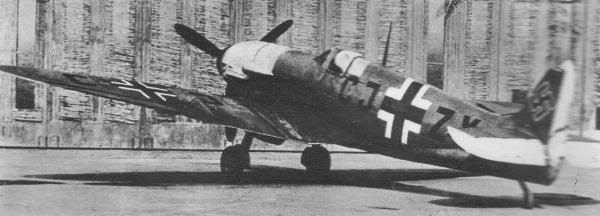
Mais informações serão postadas mais tarde.
Se acharam estranho esses Spitfires com pintura alemã, que tal esses "Bf109" com pintura inglesa?
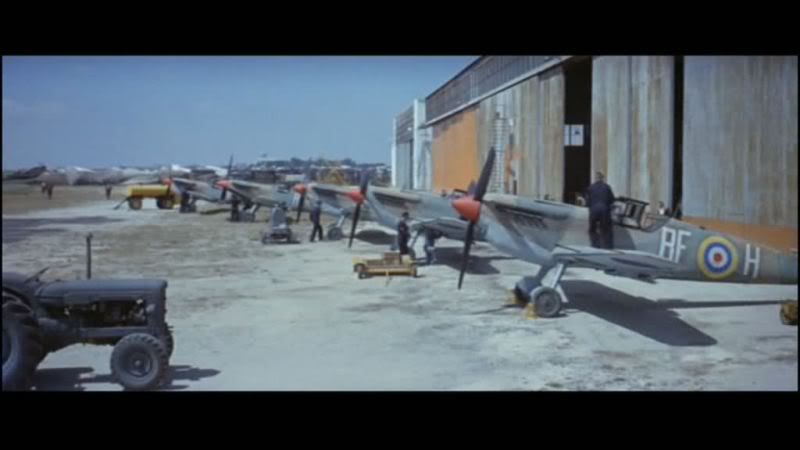
Tem mais fotos desse filme aqui:
http://s113.photobucket.com/us...ms?sort=3&page=1
O filme é esse:
http://www.imdb.com/title/tt0064571/
A história do Zirkus Rosarius.
Com o aumento da atividade aérea aliada sobre o continente, muitas aeronaves aliadas, britânicas e americanas, caíram em território controlado pela Alemanha. Algumas delas puderam ser reparadas e voltar ao serviço ativo formando uma curiosa unidade da Luftwaffe chamada de Zirkus Rosarius, também conhecida como Wanderzirkus Rosarius ou Sonderkommando Rosarius.
Sua principal tarefa era provar as capacidades de voo e combate das aeronaves aliadas. A unidade foi formada sob o comando do Hauptman Theodor Rosarius de julho de 1944 até maio de 1945. Era tratada por 2.Staffel Versuchstaffel für Feindflugzeuge (Esquadrão de Estudos de Aeronaves Inimigas) também denominada, de maneira não oficial, Beute Staffel.
Sua principal função foi fazer com que os pilotos da Luftwaffe se acostumassem com as aeronaves do inimigo, mostrando as capacidades e táticas de combate empregadas pelos pilotos aliados.
As aeronaves mantiveram seus esquemas de color originais, porém, para evitar serem derrubadas pela flak ou pelos próprios caças alemães, toda a superfície inferior da aeronave foi pintada de amarelo brilhante e na seção da cauda marcou-se com Balkenkreutz bem como a suástica na deriva, de grandes proporções.
Diversos pinturas dos Spitfire PRXIs operados pelo Zirkus Rosarius, e alguns outros modelos também usados.
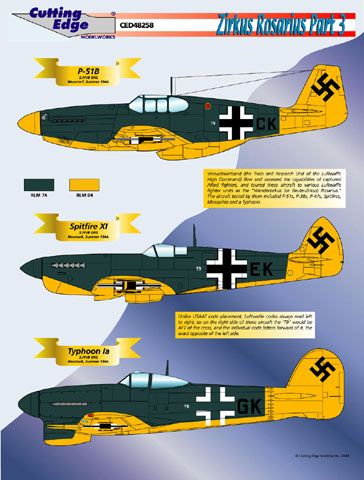
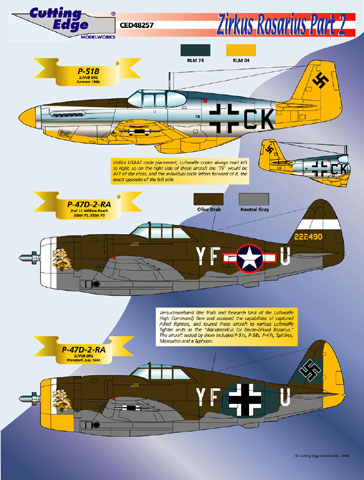
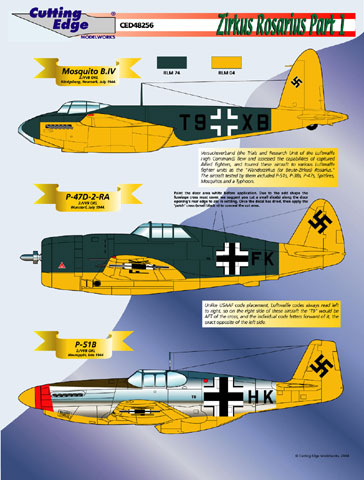
A seguir, as fotos...
A s fotos de algumas das aeronaves do Zirkus Rosarius e de outras unidades operacionais alemãs.
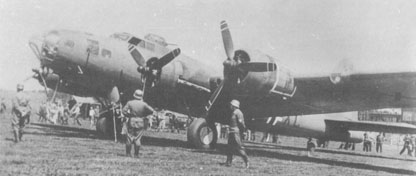

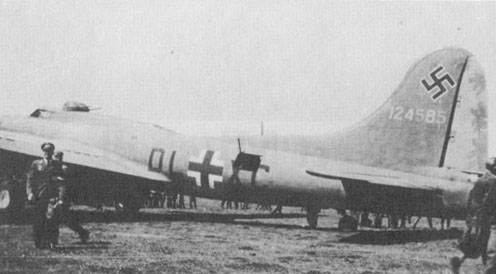
B-17F Flying Fortress (41-24585) Wulf hound ou Wolf Hound, a primeira do seu tipo a ser capturada (7 no total) quase intacta após uma aterrissagem forçada em Leeuwardeen, em 12 de dezembro de 1942. Inicialmente marcada como DL+XC, foi transferida para o KG 200 (como todas as demais em Setembro de 1943, com número de série A3+AE.

Ex-RAF Typhoon codificado T9+GK e usado pelo 2./Versuchsverband O.b.d.L.

Quase 100 Il-2 foram capturados, mas não foram sequer usados, nem para fins de treinamento, pela sua pobreza técnica e capacidade de voo. Foram usados como alvos terrestres ou exposição de troféus.

B-26B Marauder 41-17790
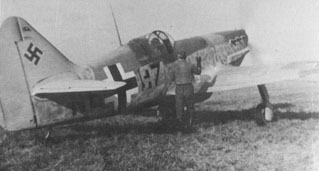
Dos 246 caças Dewoitine D.520C1 capturados, apenas 182 foram usados para combate ou treinamento operacional de tripulações dos Ar 96.

P-47F-2-RA (42-22490) foi capturado intacto após um pouso bem sucedido pelo seu piloto, em 7 de novembro de 1943.

